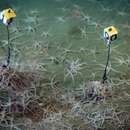en
names in breadcrumbs


"Typically on mud bottoms." (Lambert, Austin 2007)
"Easily confused with Ophiura luetkenii, which co-occurs with O. sarsii." (Lambert, Austin 2007)
"Disc: Up to 40 mm in diameter with rounded sides. The radial shields are roughly triangular, about twice as long as their width. The arm combs are composed of conical or triangular papillae separated at their tips.
Arms: The dorsal arm plates are short and wide; the ventral plates are triangular and usually separated by the bases of the lateral arm plates. Each arm has three spines: the upper two are 1.5 to 2 times as long as a joint; at the arm tip, the middle spine is longest. The tentacle scales are broad and flat, four or five to each podial pore, but as few as one distally.
Mouth: Four to six pointed oral papillae on each side. Narrow adoral shields partially wrap around the oral shield, which is as broad as it is long.
Colour: The disc is usually brown or grey, but may be mottled. The arms are grey or lighter than the disc. Both the disc and arms are white ventrally." (Lambert, Austin 2007)
"This species has seperate sexes. In the San Juan Islands, ripe specimens collected from March to June will spawn in the lab." (Lambert, Austin 2007)
"This opportunistic carnivore feeds on small benthic invertebrates, carrion and detritus, but it has also been observed attempting to catch larger organisms near the bottom. The distal two-thirds of the arms are raised and ready to encircle prey, such as myctophid fish, euphausids and small squid, that blunder into the ocean bottom, if a brittle star captures an animal, others join in to share the meal." (Lambert, Austin 2007)